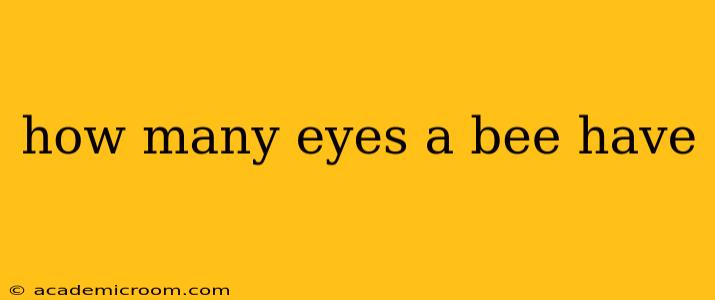Bees, those industrious pollinators buzzing around our gardens and fields, possess a fascinating visual system far more complex than you might imagine. The simple answer is: a bee has five eyes. However, understanding how these eyes function and what they allow the bee to see reveals a whole world of intricate sensory perception. Let's delve into the specifics.
What are the five eyes of a bee?
A bee's visual apparatus consists of two large compound eyes and three smaller ocelli. Let's break down each type:
-
Compound Eyes: These are the most prominent eyes, located on the sides of the bee's head. They are made up of thousands of individual light-detecting units called ommatidia. Each ommatidium acts like a tiny lens, capturing a small portion of the visual field. The collective image from all these ommatidia creates a mosaic-like overall picture. This type of vision allows bees to detect movement exceptionally well and perceive polarized light, crucial for navigation.
-
Ocelli: These are three smaller, simple eyes located on the top of the bee's head, forming a triangle. Their function isn't fully understood, but scientists believe they primarily help the bee detect changes in light intensity, aiding in orientation and flight stability. They don't form images like compound eyes.
How does a bee's vision differ from human vision?
Bees see the world very differently from us. Their vision is:
-
Mosaic: As mentioned, the compound eyes create a mosaic-like image, not a sharp, detailed one like our eyes. However, this mosaic vision is highly effective at detecting movement and patterns.
-
Ultraviolet Sensitive: Bees can see ultraviolet (UV) light, which is invisible to humans. Many flowers have UV patterns that act as "nectar guides," visible only to bees and other pollinators. This allows bees to easily locate the flower's reproductive parts.
-
Color Perception: While they can't see the full spectrum of colors that humans can, bees have excellent color vision, perceiving colors in a different way. For instance, they can distinguish between blues and greens, but they may struggle to see red.
Can bees see in the dark?
No, bees cannot see in complete darkness. Their vision relies on light, although they are more sensitive to low-light conditions than humans.
What is the importance of a bee's vision for its survival?
A bee's vision is essential for its survival. It enables them to:
- Locate flowers: Identifying flowers based on color, shape, and UV patterns.
- Navigate: Using the sun, polarized light, and landmarks for orientation during flight.
- Detect predators: Quickly spotting potential threats.
- Communicate: Performing the waggle dance, a form of communication that utilizes movement and visual cues.
What are some common misconceptions about bee vision?
A common misconception is that bees only see blurry images. While their vision isn't as sharp as ours, it's far from blurry. Their vision is highly specialized and optimized for their needs as pollinators.
In conclusion, the next time you see a bee flitting about, remember the remarkable visual system that guides its every move – five eyes working in perfect harmony to ensure its survival and contribute to the vital process of pollination.
